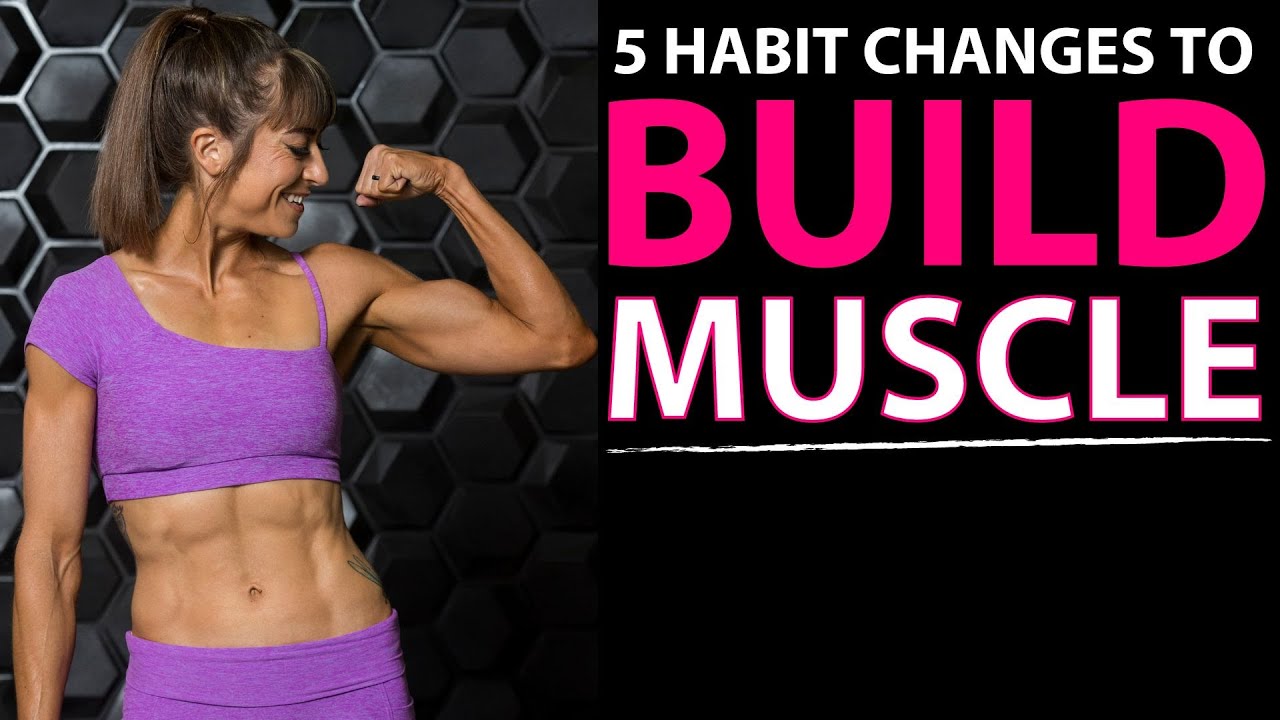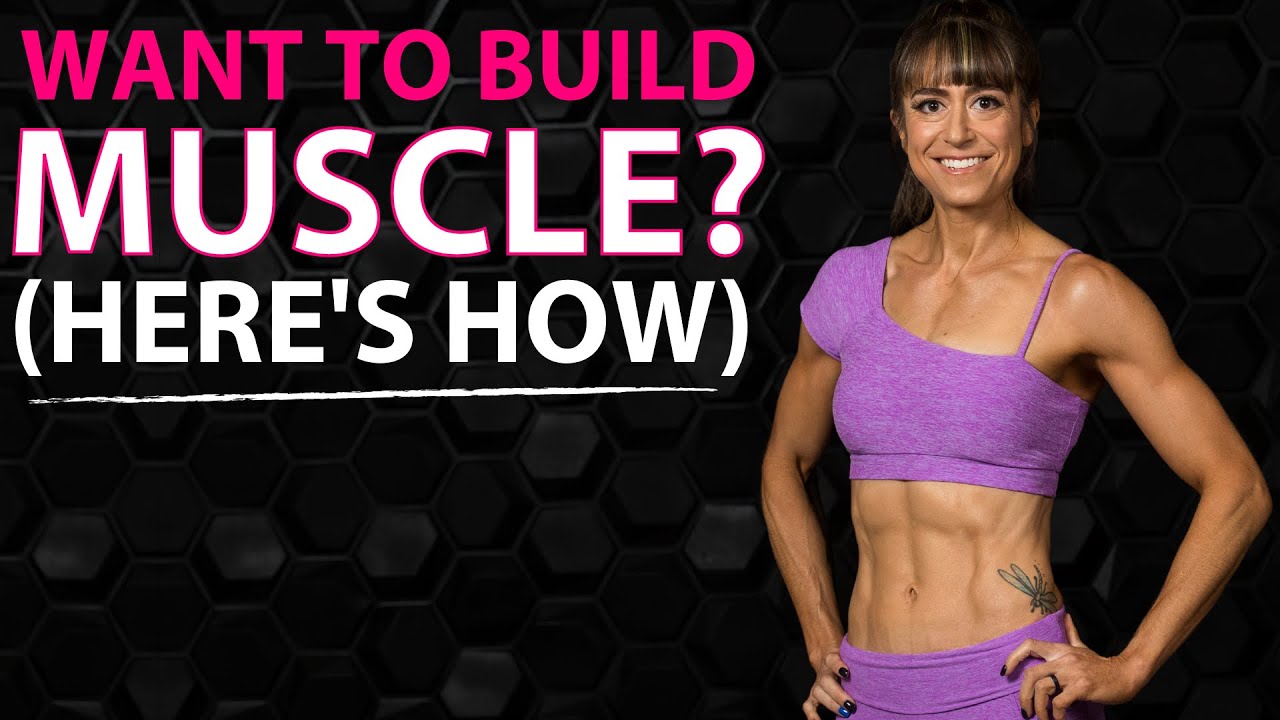
How To Build Muscle ( 5 HABIT CHANGES)
Often when we want to achieve a new goal, a new result, we look for a new program, a new set of routines or habits to implement.
But too often we don’t assess habits we may currently have that we actually need to STOP doing.
And many of these old habits even sneak into our new programming ultimately holding us back from our new goal.
Many of these habits we hold on to because they worked for our previous goals – say for weight loss or fat loss.
But when our focus changes, our habits need to shift as well.
And to gain muscle we can’t repeat the same habits that worked for weight loss. Gaining muscle means embracing habit changes.
We have to remember that what worked for one goal may not work for another and could even hinder us from seeing results.
That’s why I wanted to share 5 habits many of us excuse that we actually need to STOP doing if we want to gain more muscle.
5 Habits To Stop Doing If You Want To Gain More Muscle FASTER:
It’s hard at times to let go of habits that “worked” or that we enjoyed even when we logically know they no longer fit our goals.
But it’s key we do make sure our lifestyle is evolving to match our changing needs and goals.
Habit #1: Working Out Every Day
“But I love working out!”
“I feel guilty if I don’t do something every day.”
Many of us have said these statements as an excuse to train every day.
And while we may “get away with it” more in a fat loss phase, even then this mindset backfires.
Our body rebuilds and functions optimally when it has time to rest and rebuild.
You need quality recovery. You need proper fueling. You need quality sleep.
You need days where your body and mind can relax and repair so you are prepped to push hard in the following training sessions.
Make sure that you are designing your workouts progressions to give areas rest over the course of the week and even cycling your training intensity.
Getting results doesn’t have to mean, and shouldn’t mean, destroying ourselves every session.
Especially as we get older, our recovery times can increase. This means designing programs strategically to account for this. While it doesn’t mean we can’t still train 5-6 days a week, the way we break up our sessions and the volume we create may vary!
And remember it isn’t just your body but also your MIND that actually needs the recovery time.
It is fatiguing really trying to mentally push yourself every workout to create that progression you need to see results.
You want to be focused and intentional every training session – not just go through the motions.
So we have to recognize how taxing mentally that is, especially combined with a stressful day.
Give yourself time to rest and recover so every session is quality!
We rebuild when we rest and that’s how we see those muscle gains!
Habit #2: Changing your workouts up constantly
While it can be fun to do different things often, we need to design a clear progression to follow if we want to see results.
Changing up our workouts doesn’t allow us to strategically push and get the full benefit of each move.
It can also make us constantly sore, which can negatively impact muscle activation and subsequent training sessions.
Include a variety of movements to work muscles in different ways over the course of the week, but clearly lay out a progression you repeat for a few weeks.
How long you repeat a progression may depend on:
- How much room for growth you have with moves
- How much you find ego starts to get in the way when you are hitting your upper limit with an exercise (encouraging you to lift more than you probably should with form that isn’t ideal)
- How much you do even find your mental focus drifting as you get “bored”
Progressions don’t have to be done for months upon months.
Just remember too that being able to push and see how far you can go with an exercise can be exciting!
Over time you can test out different workout designs and movements. But without repeating a set progression for a bit, you can’t know what does and doesn’t work. It allows you to actually see yourself progressing with one extra rep, 5lbs more or even that full pull up when you couldn’t do one prior!
But that progression is needed if you want to dial in those muscle gains efficiently so you actually are truly progressing moves and not just making yourself sore with different and new!
Because soreness really isn’t an indicator that you’re building more muscle, especially not more muscle faster!
Habit #3: Staying in your comfort zone
It can honestly be hard to push every training session.
While fun in a torturous way, it is at times mentally and physical hard and uncomfortable to push for another rep. Use a bit more weight we aren’t sure will go up for that final rep.
Do that new variation that really challenges us.
It is easy to keep repeating the same exercise variations, with the same loads for the same reps or sets at times.
But muscle growth is the result of challenging our body to have to adapt and repair to become stronger.
That means we need to focus on that progression in our loads, tempos, variations, training density…
Sometimes it may be one more rep in one set.
Sometimes it may be just 5lbs more.
Sometimes it may be moving on to a different tempo or posture or position for a move to use progression through the same but different.
This though is also why a clear workout progression and schedule is key.
It allows us to make those incremental adjustments to push ourselves outside our comfort zone each week.
And over those progressions, we also can’t fear testing out new workout designs and training methods.
Especially the more advanced a trainee we are, the slower our results will be so the more some advanced strategies, training techniques and workout designs may need to be used at times. Not only to challenge our body but also keep us wanting to push mentally with something new in our workouts.
You may experiment with things like rest-pause technique, drop sets, density training…It isn’t just loads we can use to challenge our body and push ourselves outside what is comfortable to create that muscle growth and change!
Habit #4: Going Low Carb
So I’ve talked a ton about training so far, and it’s because you can’t build muscle without a proper training routine and resistance to create growth.
While weight loss and fat loss are so much about diet, building muscle requires you to train in a way that forces your body to adapt and build back stronger.
However, our diet can’t be ignored if we want the best results from those intensive training sessions! We don’t want our hard work in the gym to be wasted!
That’s why it is key we give our body the fuel it needs to rebuild and repair and have the energy to train hard.
And carbs are truly a key part of having that readily available energy to not only push hard during our sessions but rebuild post workout.
They create that anabolic environment optimal for muscle growth.
Carbs are not only that immediate energy to be able to push at our full intensity during training and create that progressive overload but they are also protein sparring.
They protect your lean muscle from being catabolized or used as fuel and they can help make sure that the protein you consume is used to actually rebuild.
This is extra key if you are an endurance athlete or enjoy steady state cardio and refuse to fully cut back on mileage. Cardio already makes it harder to build and retain lean muscle, so carbs are even more key to serve as that immediate energy source and aid in our recovery.
So while you may have dropped your carbs during your weight loss cycle, you may now find boosting them to be extremely key.
Too often we keep ourselves in that energy deficit and then wonder why we aren’t gaining muscle. But growth can’t truly happen when we don’t have the fuel to repair or even optimize hormone levels.
So increase those carbs.
Even if you start by just timing more carbs around your training sessions, you can’t fear carbs if you want the most efficient muscle gains.
Habit #5: Staying In A Deficit
Just like we may have cut carbs during a fat loss phase, we often focus on that calorie deficit to see results. You do need to consume less than you expend to see that fat loss because you need to tap into that stored energy.
But to gain muscle as efficiently as possible, you now need to make sure your body always has the fuel it needs. So you can’t fear eating more.
Eating too little will keep you training hard and not seeing any gains. It can also lead to burn out, constant fatigue, constant soreness and an inability to recover.
Basically you could feel like you’re working so hard to literally not see any gains.
If you are transitioning out of a fat loss phase, you may simply start by increasing your calories to more of a maintenance level while increasing carbs. From there you may enter a small surplus.
Eating more doesn’t give you the excuse to go crazy. If you do a dirty bulk and skyrocket your calories, you’re going to gain fat and ultimately not really see better results.
A surplus as little as 100 calories may be enough although you may find you need to increase up to 400 above maintenance, which is why it may be helpful to do a maintenance phase prior to learn what you need to maintain your current body comp.
By focusing on protein and not ignoring this essential macro, you can even gain muscle while in a deficit so a slower transition, increasing calories can help you avoid gaining fat.
But we have to remember that the leaner we get, and the more we aren’t eating sufficiently to fuel our training, the more we put ourselves at risk for losing muscle even with higher protein ratios.
You need that fuel to grow those muscles!
And making sure that you’re eating enough is essential even as we enter menopause!
Often under fueling and extreme dieting habits can create metabolic adaptations which hold us back from not only losing fat, but gaining muscle as we enter menopause.
So focusing on increasing your calorie intake and building muscle is KEY as we get older to keep our metabolic rate higher!
Just remember because you can “get away with” something when you’re younger doesn’t mean that dieting practice won’t catch up with you later!
If you are peri-menopausal or nearing that age, really focus on making sure you’re building that lean muscle and not under eating or you could be setting yourself up for unwanted fat gain and muscle loss as you get older!
SUMMARY:
So if you’re looking to build muscle as quickly as possible it is key you change your habits, especially from the habits you used to lose weight or fat.
Focus on challenging yourself with your training and eating enough to support that muscle growth.
For accountability and support to see better results FASTER, apply to my 1:1 Coaching.



